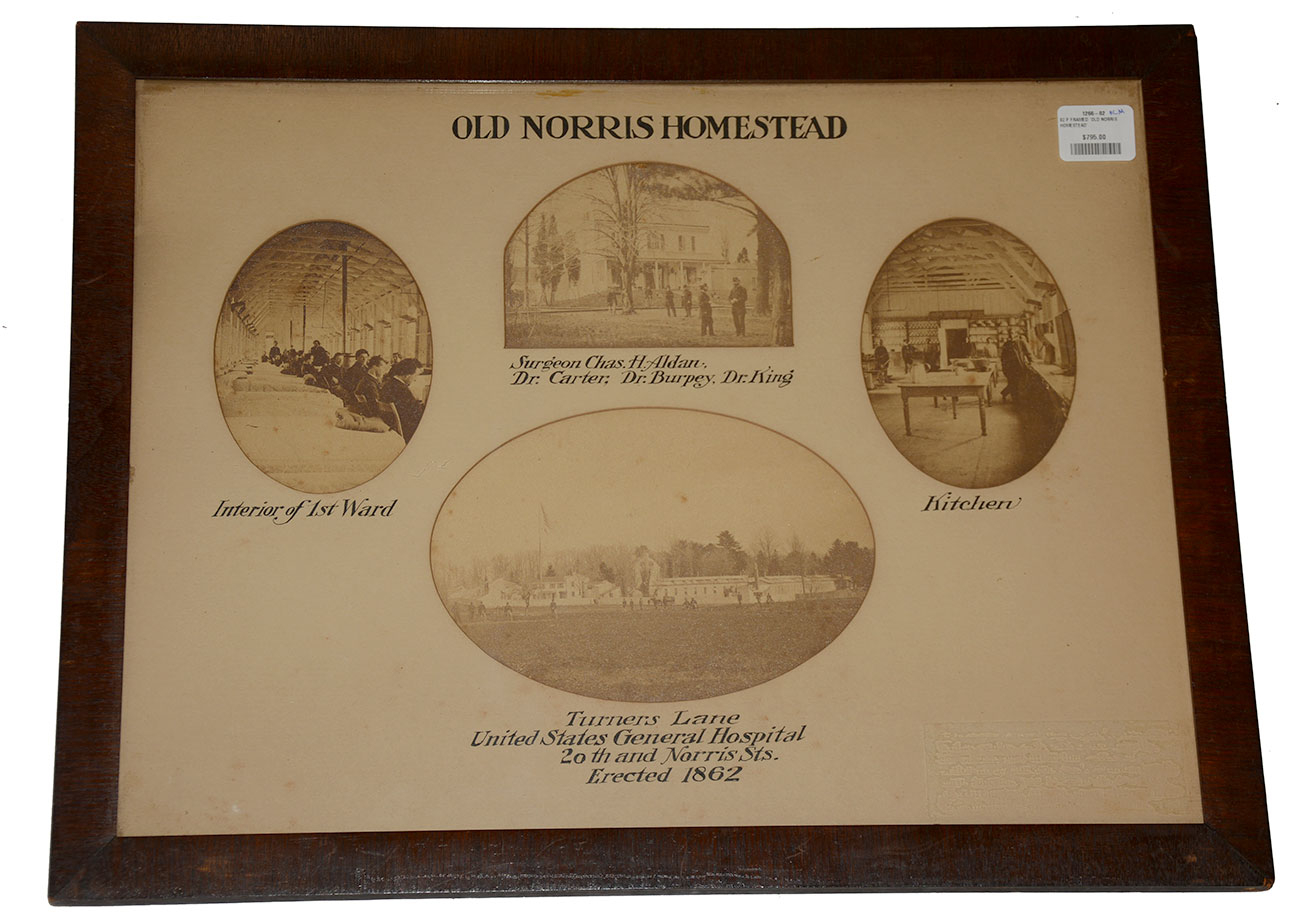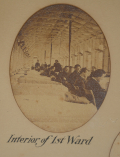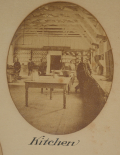site search
online catalog
VERY RARE PHILADELPHIA CIVIL WAR HOSPITAL PHOTO GROUPING – TURNER’S LANE, GETTYSBURG WOUNDED, FIRST NEUROLOGICAL RESEARCH CENTER!

$795.00 SOLD
Quantity Available: None
Item Code: 1266-02
From their disparate backgrounds, Philadelphia physicians S. Weir Mitchell, William W. Keen, and George R. Morehouse assembled one of the most unusual and important temporary hospital wards during the last year of the Civil War at Turner’s Lane in Philadelphia. The rehabilitative care afforded to 160 soldiers at Turner’s Lane, many of whom had been wounded at Gettysburg, provided an unparalleled opportunity to study diseases and wounds of the nerves, particularly peripheral nerve injuries. Mitchell, the leader of the team, and his colleagues were conscious of the history-making nature of their work: “The opportunity was indeed unique and we knew it … it was exciting in its constancy of novel interest.” Mitchell’s literary talents produced benchmark treatises on nerve injuries and popular fiction based on Turner’s Lane, most famously regarding the “phantom limb” phenomenon, a term he coined. Dr. Robert Hicks recounts the achievements of Turner’s Lane with emphasis on the regimen followed by these three young physicians, that produced scientific insights which secured the discipline of American neurology.
Erected in 1862 and in service from 1863, the “Rest Cure” pioneered by Dr. Mitchell for nervous system injuries and disorders became the focus of some of the most important medical research in US History to date.
Working under a regular surgeon, Mitchell was joined by Dr. William W. Keen and Dr. George Morehouse at Turner’s Lane. They focused exclusively on nerve injuries among soldiers, working as a team. The team examined and treated various forms of nerve damage, resulting from all kinds of injuries including gunshots, artillery shells, sabre swipes, falls and accidents. Nerve damaged soldiers, who had previously bounced around hospitals like hot potatoes, flooded their ward. One such soldier was a seventeen-year-old Pennsylvania native named David Schively. Schively, a private in the 114th Pennsylvania Volunteer Infantry, had been wounded at the Battle of Gettysburg. During the second day of fighting, Schively rose up to fire his musket when an enemy ball smashed through his shoulder.
To make things worse he was also shot in the face as he left the field, leaving him blind in his right eye. He survived but soon began to suffer with a “burning pain in the palm and fingers” of his right hand. By December 1863, the pain was so intense that the only remedy that brought Schively any relief was to keep both hands “covered with loose cotton gloves, which he wets at brief intervals.” The pain had made him so “nervous and hysterical” that his “relatives supposed him to be partially insane.”
These were the injuries that interested the Turner’s Lane team; injuries to nerve centers, to the sympathetic nerve, and to nerve trunks or branches. They were also interested in changes to the muscles, including paralysis, and loss of tone and firmness. Mitchell achieved a number of groundbreaking discoveries while treating wounded Civil War soldiers. He and his team were one of the first to demonstrate the use of electricity as a form of treatment.[10] Mitchell would use electricity to stimulate the nerves and muscles, and to see whether neural connections could be remade, and if muscles could recover. Their work on reflex paralysis due to indirect lesion of the nerve substance, was considered, as Dr. Shauna Devine writes “their greatest contribution to the field.”[11] They also experimented with painkilling drugs such as morphia and atrophia, concluding that morphia was the most effective drug for relieving pain. Finally, Mitchell, Morehouse and Keen published a wartime publication Gunshot Wounds and Other Injuries of the Nerves, which was based on their notes and spelled out how to diagnose and treat nervous wounds.
This stunning collection of photographs comes with a period wood veneer frame with a beautiful striped grain pattern. Original glass is in excellent condition for its age, with minimal imperfections. The custom matting is labeled “OLD NORRIS HOMESTEAD” in bold, printed letters. Four labeled vignettes are accompanied by four photos. The first photo is labeled “Interior of 1st Ward” and shows convalescing soldiers and officers. The second photo at top shows key physicians and is labeled “Surgeon Chas. H. Aldan, Dr. Carter; Dr. Burpey, Dr. King. The second photo at bottom is a view of the hospital complex and is labeled “Turners Lane United States General Hospital 20th and Norris Sts. Erected 1862”. The final photo on the far right is labeled “Kitchen”.
Period photographs of Tuner’s Lane are exceptionally difficult to find and these fine examples are ready for display. The framed piece measures 18.5” in length and 14.5” in width, while the width of the frame itself is 1”. The matting is in excellent condition as are the photos, with only a spot of minor damage at the upper edge of the top photo. The reverse is composed of heavy pressed paper affixed by finishing nails extending from the frame. It is unmarked but retains the wire and loops necessary for secure mounting and display.
A truly scarce opportunity to own a piece of medical history from one of the most important hospital sites of the Civil War. This piece should appeal to a broad spectrum of collectors of Civil War, Philadelphia, and medical history. [CM] [ph:L]
~~~~~~~~~~~~~~~~~~~~~~~~~~~~~~~~~~~
THIS ITEM, AS WITH ALL OTHER ITEMS AVAILABLE ON OUR WEB SITE,
MAY BE PURCHASED THROUGH OUR LAYAWAY PROGRAM.
CLICK HERE FOR OUR POLICIES AND TERMS.
THANK YOU!
Inquire About VERY RARE PHILADELPHIA CIVIL WAR HOSPITAL PHOTO GROUPING – TURNER’S LANE, GETTYSBURG WOUNDED, FIRST NEUROLOGICAL RESEARCH CENTER!
For inquiries, please email us at [email protected]
Most Popular
Historical Firearms Stolen From The National Civil War Museum In Harrisburg, Pa »
Theft From Gravesite Of Gen. John Reynolds »
Selection Of Unframed Prints By Don Troiani »
Fine Condition Brass Infantry Bugle Insignia »
Wonderful Condition Original Confederate-Manufactured Kepi For A Drummer Boy Or Child »
featured item
CONFEDERATE FIRST NATIONAL FLAG FROM ISLAND NUMBER TEN
This Confederate First National flag has a tight provenance going back to 1935, and before that an oral history as a war souvenir brought back from Island Number Ten by James William McLaughlin, a prominent Cincinnati architect who in 1861 had served… (1179-004). Learn More »







